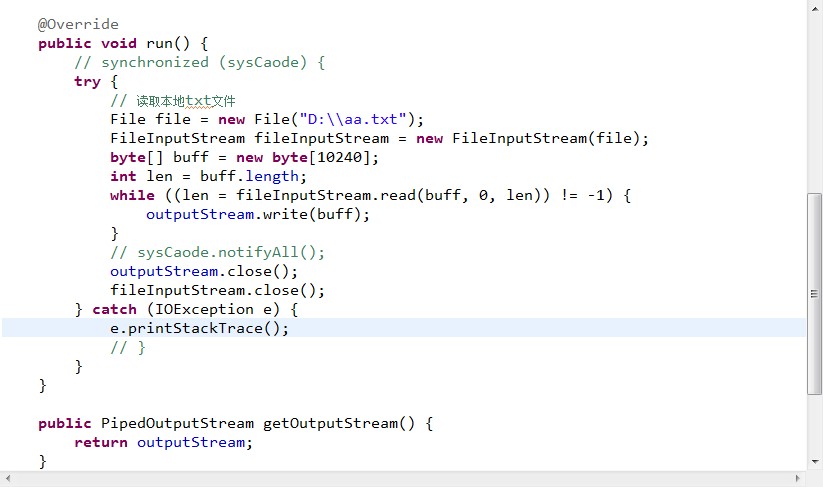java.io.IOException: Pipe closed
Posted
tags:
篇首语:本文由小常识网(cha138.com)小编为大家整理,主要介绍了java.io.IOException: Pipe closed相关的知识,希望对你有一定的参考价值。
使用PipedOutputStream发送数据到PipedInputStream,从本地读取txt文件,如果文件里的数据太大就会出现java.io.IOException: Pipe closed;
下面是我的代码
求完整的解答思路!

调试了很多次,不知道如何解决
追答你这么做一下,把io关闭的地方都写在finally里面,别写在try里面试试。
把inputThread.start()和outpuThread.start()换一下执行顺序。
一样,还是报这个错..
追答ouputStream write完后 flush();
参考技术Bpublic static void main(String[] args)
这个跟虚拟机的内存关系不大吧,文件十几KB就出这个异常了!
追答只有在start的时候才会执行run的方法,run的方法又是结束的时候才关闭in或者outputstream,得看到更多代码才能确定问题,能发全部的代码吗?
追问这就是全部的代码了,没有其他代码了
PipedInputStream - 如何避免“java.io.IOException:Pipe broken”
我有两个主题。其中一个写入PipedOutputStream,另一个从相应的PipedInputStream读取。背景是一个线程正在从远程服务器下载一些数据,并通过管道流将其多路复用到其他几个线程。
问题是有时候(特别是在下载大型(> 50Mb)文件时)我得到java.io.IOException:试图从PipedInputStream读取时管道坏了。
Javadoc说A pipe is said to be broken if a thread that was providing data bytes to the connected piped output stream is no longer alive.
确实,我的写作线程在将所有数据写入PipedOutputStream之后真的死了。
有解决方案吗如何防止PipedInputStream抛出此异常?我希望能够读取写入PipedOutputStream的所有数据,即使编写线程完成了他的工作。 (如果有人知道如何继续写线程直到所有数据都被读取,这个解决方案也是可以接受的)。
使用java.util.concurrent.CountDownLatch,并且在第二个线程发出信号已完成从管道读取之前,不要结束第一个线程。
更新:快速和脏代码,以说明我的评论如下
final PipedInputStream pin = getInputStream();
final PipedOutputStream pout = getOutputStream();
final CountDownLatch latch = new CountDownLatch(1);
InputStream in = new InputStream() {
@Override
public int read() throws IOException {
return pin.read();
}
@Override
public void close() throws IOException {
super.close();
latch.countDown();
}
};
OutputStream out = new OutputStream(){
@Override
public void write(int b) throws IOException {
pout.write(b);
}
@Override
public void close() throws IOException {
while(latch.getCount()!=0) {
try {
latch.await();
} catch (InterruptedException e) {
//too bad
}
}
super.close();
}
};
//give the streams to your threads, they don't know a latch ever existed
threadOne.feed(in);
threadTwo.feed(out);
当你正在使用它的线程结束时你关闭你的PipedOutputStream吗?您需要这样做,以便将其中的字节刷新到相应的PipedInputStream。
PipedInputStream和PipedOutputStream被打破(关于线程)。他们假设每个实例都绑定到一个特定的线程。这很奇怪。我建议使用您自己的(或至少是不同的)实现。
当您使用多个读取器或编写器线程时,您可能会遇到这些类的问题(请参阅JDK-4028322)。
但是大多数用户可能只使用一个阅读器和一个编写器线程。既然你也是这种情况,那么你遇到破裂的管道的原因很可能就是你写完后你没有close PipedOutputStream。
PipedOutputStream out = new PipedOutputStream();
PipedInputStream in = new PipedInputStream(out);
// You can of course also use an Executor or similar for this
new Thread(() -> {
// Your method writing the data
writeDataTo(out);
// Close PipedOutputStream so that reader knows that the end of the data
// has been reached
try {
out.close();
}
catch (IOException e) {
// Handle exception or simply ignore it; current implementation will NEVER
// throw an IOException: https://github.com/openjdk/jdk/blob/0e14d5a98453407488057e6714f90f04d7dfa383/src/java.base/share/classes/java/io/PipedOutputStream.java#L174
}
}).start();
// Your method reading the data
readDataFrom(in);
// Close PipedInputStream so that writer fails instead of blocking infinitely in case
// it tries to write again (for whatever reason)
in.close();
也没有必要手动调用PipedOutputStream.flush(),它只通知等待的读者,但如果直接调用close(),则不会丢失任何数据。
可悲的是,文档目前还不是很清楚所有这些。一般来说,依靠实现并不是一个好主意,但在这种情况下,它可能是唯一明智的解决方案:
- https://github.com/openjdk/jdk/blob/master/src/java.base/share/classes/java/io/PipedInputStream.java
- https://github.com/openjdk/jdk/blob/master/src/java.base/share/classes/java/io/PipedOutputStream.java
以上是关于java.io.IOException: Pipe closed的主要内容,如果未能解决你的问题,请参考以下文章